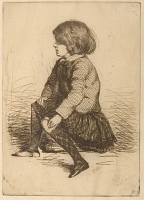Seymour Haden, Jr, Seated | ||
| Number: | 9 | |
| Date: | 1857/1858 | |
| Medium: | etching | |
| Size: | 137 x 98 mm | |
| Signed: | 'J Whistler' at lower left (obscured by shading) | |
| Inscribed: | no | |
| Set/Publication: | no | |
| No. of States: | 3 | |
| Known impressions: | 24 | |
| Catalogues: | K.29; M.6; T.16; W.22 | |
| Impressions taken from this plate (24) | ||
KEYWORD
boy seated, clothing, dress, kilt, portrait.
TITLE
The main alternatives in title, concerning whether or not to name the sitter, are given below:
'Seymour Haden - Junr.' (1870s, Whistler). 2
'Seymour Haden, seated' (1872, British Museum). 3
'A Little Boy' (1874, Ralph Thomas, Jr (1840-1876)). 4
'Seymour Haden' (1881, Union League Club). 5
'A Little Boy (Seymour Haden)' (1900, Caxton Club). 6
'The Little Boy' (1903, Obach's). 7
'Seymour, Seated' (1909, Howard Mansfield (1849-1938)). 8
The revised title 'Seymour Haden, Jr, Seated' distinguishes this etching from another portrait of the same sitter, Seymour, Standing [10],
'Seymour Haden - Junr.' (1870s, Whistler). 2
'Seymour Haden, seated' (1872, British Museum). 3
'A Little Boy' (1874, Ralph Thomas, Jr (1840-1876)). 4
'Seymour Haden' (1881, Union League Club). 5
'A Little Boy (Seymour Haden)' (1900, Caxton Club). 6
'The Little Boy' (1903, Obach's). 7
'Seymour, Seated' (1909, Howard Mansfield (1849-1938)). 8
The revised title 'Seymour Haden, Jr, Seated' distinguishes this etching from another portrait of the same sitter, Seymour, Standing [10],
3: B.M. Print Room Register of Purchases ... 1872.
4: Thomas 1874 (cat. no. 16).
5: New York 1881 (cat. nos. 32-3).
6: Chicago 1900 (cat. no. 22).
7: London Obach 1903 (cat. no. 23).
8: Mansfield 1909 (cat. no. 6).
DESCRIPTION
A young boy, Francis Seymour Haden, Jr (1850-1918), is seated looking to left. His hair is thick and wavy, reaching his collar, with a heavy fringe. A black ribbon-like cravat is tied round his short, turn-down collar; his jacket fastens with a single button, at the top; a loosely gathered skirt or kilt, with a broad band or ribbon just above the hem, reaches just below his knees; he wears long plaid socks, and light-weight shoes, possibly dancing shoes.
SITTER
Francis Seymour Haden, Jr (1850-1918). Whistler wrote: ' "Seymour Haden, Junr." ' on an impression for Samuel Putnam Avery (1822-1904) ( ?).
?).
 ?).
?).DISCUSSION
Seymour is wearing the same dress as in Seymour, Standing [10]. Thomas and Wedmore identified the skirt as 'Scotch' but it is not really Scottish; it is certainly not a tartan kilt, but more a loose kilt typical of Victorian boy's winter dress.
